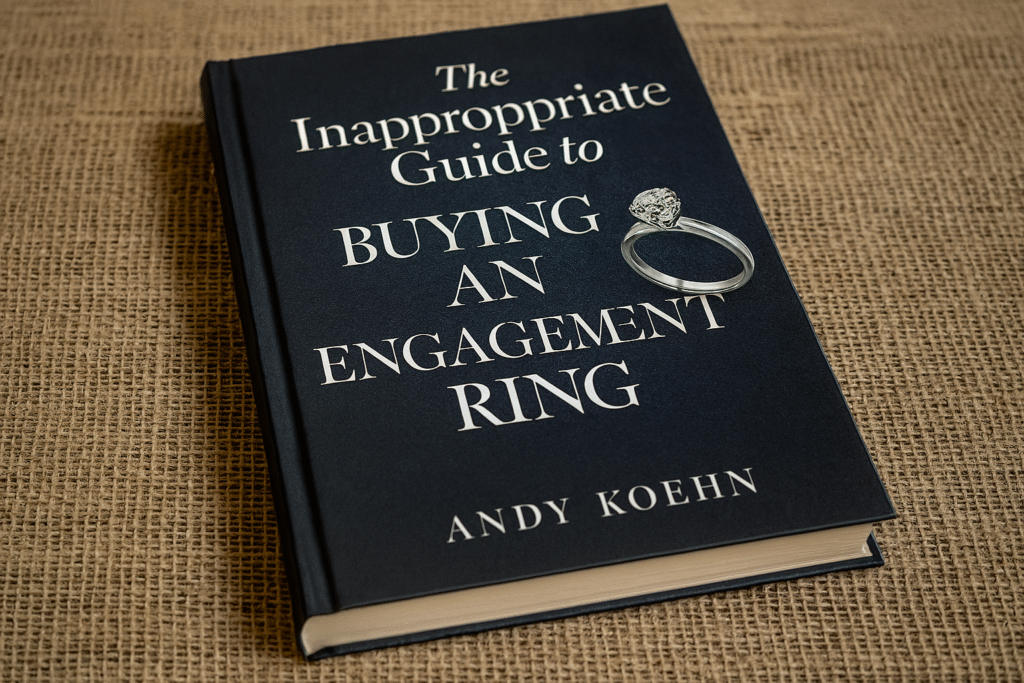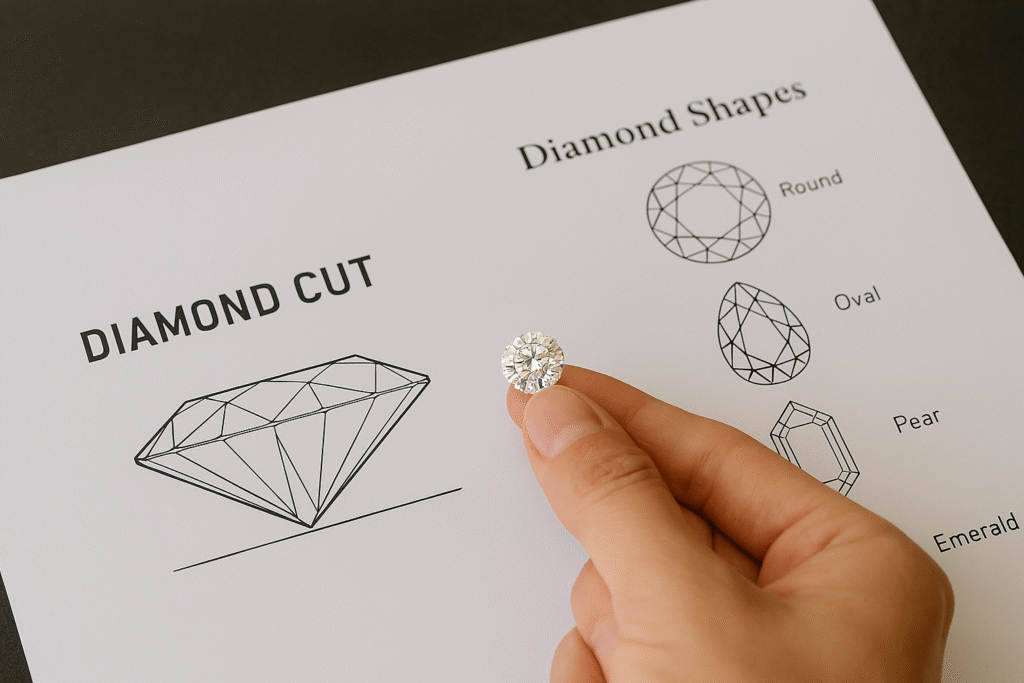Introduction
If you’re nervous about shopping for a ring, The Inappropriate Guide to Buying an Engagement Ring by Andy Koehn of Koehn & Koehn Jewelers is exactly what you need. This book is raw, practical, and full of real-world advice that helps you cut through the noise of jewelry store sales tactics. Unlike the polished brochures you usually find, Andy delivers straight talk based on decades of experience in the diamond trade.
Why the Inappropriate Guide Engagement Ring Book Matters
Buying an engagement ring is overwhelming for most shoppers. Studies show that 72% of first-time buyers feel pressured into overspending. Andy Koehn tackles that stress head-on. His Inappropriate Guide to Buying an Engagement Ring explains what truly matters and what doesn’t—without the fluff.
“The key is not to buy the ring the jeweler wants to sell you. The key is buying the ring your partner will actually love.” – Andy Koehn
Who Is Andy Koehn of Koehn & Koehn Jewelers?
- Fourth-generation jeweler at Koehn & Koehn Jewelers (over 100 years in business)
- Recognized speaker at national jewelry events
- Known for no-nonsense advice that makes buying jewelry approachable
Key Lessons from the Inappropriate Guide Engagement Ring Book
Most jewelry advice feels scripted. Andy’s book flips the script with:
- Blunt honesty
- Relatable stories
- Budget-friendly strategies
- Clear tips on diamond quality
Case Study: Shoppers Who Used the Inappropriate Engagement Ring Guide
A customer ready to spend $10,000 used Andy’s approach and bought a ring under $6,500. His fiancée loved it, and he avoided unnecessary stress.
FAQs About Andy Koehn’s Engagement Ring Guide
Q: Is the book beginner-friendly?
Yes, it’s written for first-time ring buyers who want clarity.
Q: Will it help me save money?
Yes. Many readers save 15–30% by avoiding overpriced options.
Q: Where can I learn more about diamonds?
Check out the guide on diamond grading basics.
Q: What about gold purity?
Read the article on 24K, 22K, and 18K gold differences.
Q: Buying in India?
Don’t miss our post on BIS hallmark standards.
Further reading suggestions:
- diamond grading basics, 24K vs 22K vs 18K gold, BIS hallmark guide, common mistakes in gemology
- Koehn & Koehn Jewelers official website
This comprehensive global cuisine FAQ covers everything about Asian and Western food and drinks. Whether you’re exploring international cooking techniques or discovering new flavors, this global cuisine FAQ answers the most frequently asked questions about world food traditions, ingredients, and culinary practices from both Eastern and Western cultures.
Global Cuisine FAQ: Asian & Western Food & Drinks
Food reveals cultural contrasts in clear and delicious ways. From cooking methods to dining customs, Asian and Western cuisines showcase unique traditions while also offering fascinating overlaps. Below, you’ll find answers to the most common questions about these culinary worlds.
Understanding Core Differences in Cuisine
1. What distinguishes Asian and Western culinary traditions?
Asian meals often rely on rice or noodles as a foundation. Flavors usually come from soy sauce, ginger, garlic, and a wide variety of spices. Meanwhile, Western gastronomy emphasizes bread, potatoes, and pasta. Dairy plays a key role, with butter, cream, and cheese giving richness to many dishes. Herbs such as rosemary and thyme highlight European cooking. These contrasts create distinct dining habits and flavor profiles.
2. Are Asian dishes always spicy?
No, not at all. While cuisines from Thailand and parts of India feature bold use of chilies, not every dish follows this pattern. Japanese sushi, Chinese dim sum, and Korean bulgogi are mild examples. In fact, Asian cuisines range from fiery to delicate, showcasing a rich palette of flavor.
Western Breakfast Staples and Comfort Foods
1. What constitutes typical Western morning meals?
Western breakfasts often include eggs, bacon, and toast. Pancakes, waffles, and cereal are also popular choices. These hearty starts are usually enjoyed with coffee, tea, or juice, providing both energy and comfort.
2. What represents popular Western comfort foods?
Comfort foods in the West speak to nostalgia and indulgence. Creamy macaroni and cheese, pizza, and hearty casseroles are favorites. Similarly, burgers and fried chicken have wide appeal. Because they are warm, filling, and familiar, these dishes strongly connect to emotion.
Cultural Dining Practices
1. Do all Asian cultures employ chopsticks?
No. Chopsticks dominate in East Asia—China, Japan, and Korea. However, Southeast Asia prefers spoons and forks, while India and parts of the Middle East often use flatbreads or hands. This diversity highlights how food customs closely reflect culture.
2. Why are some Asian foods fermented?
Fermentation preserves food while also enhancing nutrition and flavor. Korean kimchi, Japanese miso, and Indonesian tempeh show how tradition meets health benefits. These foods are valued not only for taste but also for their role in well-being.
Common Western Beverages
1. What beverages are common with Western meals?
Western dining often features water, soda, or fresh juice. Alcohol also has a strong cultural connection, with wine served at European dinners and beer central in North America. In the southern United States, sweet iced tea is a staple.
Dietary Flexibility and Options
1. Can one discover plant-based options easily?
Yes. Asian cuisines offer tofu stir-fries, lentil dals, and vegetable curries that are naturally vegetarian. Western food, similarly, embraces plant-based eating. Salads, vegetarian pastas, and vegan burgers have grown popular, making meat-free dining accessible worldwide.
Unique Asian Drinks to Explore
1. What are some unique Asian beverages?
Asia provides a wide variety of distinctive drinks. Bubble tea, from Taiwan, combines tea with chewy tapioca pearls. Japanese sake, made from rice, holds deep cultural meaning. Strong Vietnamese iced coffee, sweetened with condensed milk, adds a bold twist compared to Western brews.
Portion Sizes and Dining Habits
1. How do portion sizes compare?
Western meals often emphasize large servings, reflecting abundance. By contrast, Asian meals are usually smaller yet balanced, encouraging sharing and mindful eating. This creates different social experiences around the table.
The Art of Fusion Cuisine
1. Is it feasible to integrate Asian and Western flavors?
Absolutely. Fusion cuisine blends traditions in creative ways. For instance, teriyaki burgers combine Japanese flavors with American fast food, while kimchi tacos bring Korean spice to Mexican street food. These playful mixes show how food bridges cultures.




